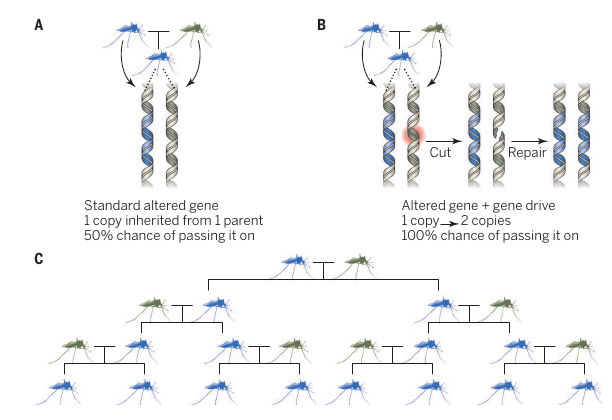Introduction
Sexually reproducing species have a 50% chance of being inherited by each offspring.
But some genes in nature have evolved ways to beat the odds: by being passed on more
than half of the time, they gain an evolutionary advantage. This can allow an
inheritance-biasing called “gene drive” that is initially present in a single
individual to
spread over many generations until it is present in all members of a population.
Aided by technological advances, scientists are investigating how populations might
be altered by adding, disrupting, or editing genes or suppressed by propagating
traits that reduce reproductive capacity, Potential beneficial uses of such “gene
drives” include reprogramming mosquito genomes to eliminate malaria, reversing the
development of pesticide and herbicide resistance, and locally eradicating invasive
species.

Gene drives are subject to two fundamental limitations. First, drives will only
function in sexually reproducing species, so they cannot be used to engineer
populations of viruses or bacteria. Second, a newly released drive will typically
take dozens of generations to affect a substantial proportion of a target
population, unless drive-containing organisms are released in numbers constituting a
substantial fraction of the population
The process may require only a year or less for some invertebrates, but centuries
for organisms with long generation times.
Theory Task
Please read the assigned pre-print titled: “Daisy Quorum Drives for the Genetic Restoration of Wild Populations ” and your own words, please answer the questions below:
1. What is the purpose of Daisy Quorum gene drive?
Daisy Quorum gene drive is a proposed technology which can restore population of genetically modified organisms into their wild/native genome confined to political boundaries. Thus it is a process of genetic modification and restoration in an ecosystem driven by the local population/ community.
2. What is your immediate emotional response after reading the preprint?
It was a wow moment to know that human intervention with the nature with genetic engineering is reversible. Creating an efficient and Genetic Reversibility precautionary approach is main essence of the work. It is the great leap forward in field of Genetic transformation.
3. Describe a scenario, real or fictional(real world is preferred), where you would deploy a technology such as Daisy Quorum".
I am from Kerala, we have a lot of coconut trees here, but in the past few years it is evident that
the coconut trees are getting worst in their health and are on a decline. One of the studies by the agriculture university
states that it is the decline in a wild breed of honeybee population which used to prefer the coconut flowers for nectar is one
of the reason for this. These bees where replaced by foreign bees which where introduced for commercial honey production.
I would like to use genetic modification to engineer a better breed of native honey bees which are competent with the foreign ones. Thus i
hope to replenish the coconut trees and once that is achieved, use this technology to restore the wild type population of bees.
4. What would you be concerned about if a neighboring country, or city, decided to deploy?
I will be concerned if somebody tries to deploy this technology without absolutely making sure that daisy necklace is impossible and their trails will be confined in their political boundaries only.
5. Is the name “Daisy Quorum” intuitive to you? If you were to name the technology, what would you name it? Note: we may actually adopt your name in the final publication!“Daisy Quorum” technology?
On the first go the name did'nt make any sense to me, but as i went though the paper it started to make sense. Rather that daisy quorum i would call it "site specific quorum"
Ethics/ safety considerations this week
Do your activities this week raise new ethics and/or safety considerations you had not considered in week 1? Describe what activities have raised these considerations and any changes you have implemented in response.
No ethics/ safety concerns for this week so far.